Kenneth L. Gentry Jr.'s Blog, page 18
February 23, 2024
FOUR DISCIPLES; TWO QUESTIONS
 PMW 2024-015 by Kenneth L. Gentry, Jr.
PMW 2024-015 by Kenneth L. Gentry, Jr.
An Important Question
A reader of my blog wrote and asked an important question:
“Hello, and thanks for the interesting blog posts!
I have a question concerning the amount of the questions Jesus’ disciples asked him in Matthew’s version of the Olivet Discourse.
Those who reject the preteristic interpretation of the discourse, argue that disciples asked three questions:
1) when will these things be (the destruction of the temple, which they admit that Jesus talks a bit)
2) what will be the sign of your coming (the second advent)
3) what will be the sign of the end of age (the end of the present world order we all are living)
My question: Is there any grammatical or other structural arguments for two and not three questions?
The Proper Answer
In Mark 13 we learn that four disciples come to Jesus and privately ask him the questions that spark the Olivet Discourse: “As He was sitting on the Mount of Olives opposite the temple, Peter and James and John and Andrew were questioning Him privately” (Mark 13:3). The number and identify of these disciples are glossed over in Matthew’s fuller version of the Discourse. Their fuller question is recorded in Matthew 24:3, which reads:
“As He was sitting on the Mount of Olives, the disciples came to Him privately, saying, ‘Tell us, when will these things happen, and what will be the sign of Your coming, and of the [a]end of the age?’”
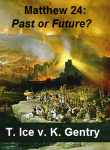
Matthew 24 Debate: Past or Future?
(DVD by Ken Gentry and Thomas Ice)
Two hour public debate between Ken Gentry and Thomas Ice on the Olivet Discourse.
See more study materials at: www.KennethGentry.com
Unfortunately, many Christians believe their question involves three issues, whereas they actually involve only two. Let me explain.
Grammatically, we must note that the disciples are asking two questions: “Tell us, [1] when will these things be, and [2] what will be the sign of Your coming [parousia] and of the end [sunteleia] of the age?” (Matt. 24:3). The two interrogatives in Greek (pote, “when” and ti, “what”) show that two questions are being asked, not three.
Furthermore, the second question has three features that show that only one additional question is being asked. The first two features are grammatical; the last one is syntactical:
1. The second interrogative is ti (“what”). It governs the whole remainder of the sentence : “what will be … the sign of Your coming and of the end of the age”? No additional interrogative appears in the question. There are only two interrogatives because there are only two questions.
2. The singular form of the word “sign” (semeion) speaks of only one remaining issue. Their question involves only one “sign” (singular). This is true even though the one singular “sign” points to a compound event. Of what is this a sign? This singular sign points to “Your-coming-and-of-the-end-of-the-age.” That is, it is one sign referring to only one eschatological episode. This is because the coming of Christ marks the end of the age.
Understanding the Olivet Discourse 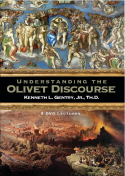
By Ken Gentry
This 5 DVD lecture set was filmed at a Bible Conference in Florida. It explains the entire Olivet Discourse in Matt. 24–25 from the (orthodox) preterist perspective. This lecture series begins by carefully analyzing Matt. 24:3, which establishes the two-part structure of the Discourse. It shows that the first section of the Discourse (Matt. 24:4–35) deals with the coming destruction of the temple and Jerusalem in AD 70. This important prophetic event is also theologically linked to the Final Judgment at the end of history, toward which AD 70 is a distant pointer.
For more educational materials: www. KennethGentry.com
Now syntactically, the feminine singular genitive definite article tes (“the”) controls both the words parousia and sunteleias: “the … sign of Your-coming-and-of-the-end-of-the-age.” The second term sunteleias lacks a resumptive article. The Granville Sharpe Rule of the Article in Greek reads: when two singular common nouns are used to describe a person or thing, and those two nouns are in the same case and are joined by a conjunction, and the definite article precedes the first noun but not the second, then both nouns refer to the same things.
This being the case, Jesus’ parousia is linked with “the end of the age,” i.e., the end of temporal history. (I have other articles pointing out that “the end of the age” is the end of history and not the end of the old covenant era. And I am working on a book on that very topic, which is so prominent in Reformed theology.)
Thus, “Jesus separates what the disciples had joined together.” Because of this, “the key to the structure of this discourse on the Mount of Olives is the disciples’ double question in 24:3.” Though the disciples assumed the destruction of the temple and the parousia were concurrent, a proper understanding of the structure of Matthew 24 shows that Jesus did not accept their connection. Consequently, how these verses are understood controls how one understands the structure of the entire discourse. So then, with these two questions (“when” and “what”), the disciples are showing their confusion: they are asking about the time of the temple’s destruction, as if it will involve his second coming which ends universal history. (See my other articles pointing out the disciples’ general tendency to confusion, and especially their clear confusion here in asking their questions.)
Click on the following images for more information on these studies:
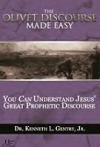

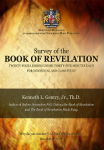
February 20, 2024
THE CONFUSED, STUMBLING DISCIPLES
PMW 2024-014 by Kenneth L. Gentry, Jr.
I am researching an expansion of my The Olivet Discourse Made Easy book. My expansion is so far-reaching in scope and large in size that I may have to rename it. Perhaps, The Olivet Discourse Made Hard. [1]
In my research I have a large section showing how confused and stumbling were Jesus’ twelve disciples — despite having the best teacher possible! Their confusion plays a large role in their misunderstanding Jesus’ prophecy of the destruction of the temple (Matt. 24:2). They ask two questions of him, the second of which shows their confusion. They ask when shall these things be, then they ask what shall be the sign of your parousia and of the end of the age (Matt. 24:3). As per much first century Jewish and apocalyptic expectations, they believed the temple could not be destroyed without history ending and that the Messiah would wage war against pagans.
So, Jesus corrects them by sorting out the issues in his Olivet Discourse (technically known as the Eschatological Discourse). The very structure of his answer shows he is distinguishing the temple’s destruction from the “parousia and the end of the age,” that is, AD 70 from the Second Advent. I will be demonstrating the two part division in the Olivet Discourse in my book. Part 1 deals with AD 70 (Matt. 24:4–31) and then after the transition (Matt. 24:32–36) part 2 deals with the parousia at the end of history (Matt. 24:37–25:46).
But back to work….
The most tragic confusion of the disciples is their inability to understand that Jesus had come into this world for the express purpose of dying and rising again from the dead. And their confusion arises despite the fact he expressly tells them this on three different occasions. And these begin only after he has accepted the title “Christ,” i.e., “Messiah (Matt. 16:15–20): Matthew 16:21; 17:22–33; and 20:17–19). And after each episode we see their confusion and Jesus’ teaching in response. Let’s briefly consider each episode.
Understanding the Olivet Discourse 
By Ken Gentry
This 5 DVD lecture set was filmed at a Bible Conference in Florida. It explains the entire Olivet Discourse in Matt. 24–25 from the (orthodox) preterist perspective. This lecture series begins by carefully analyzing Matt. 24:3, which establishes the two-part structure of the Discourse. It shows that the first section of the Discourse (Matt. 24:4–35) deals with the coming destruction of the temple and Jerusalem in AD 70. This important prophetic event is also theologically linked to the Final Judgment at the end of history, toward which AD 70 is a distant pointer.
For more educational materials: www. KennethGentry.com
Matthew 16:21
“From that time Jesus began to show His disciples that He must go to Jerusalem, and suffer many things from the elders and chief priests and scribes, and be killed, and be raised up on the third day.”
This is dramatically clear statement from their Master given to the disciples alone. They were not distracted by large crowds pressing in on them. But because he repeatedly charges them with being of “little faith” (Matt. 6:30 [2]; 8:26; 14:31; 16:8), we should not be surprised that they stumble badly in their response. Notice Peter’s response and Jesus’ rejoinder:
“Peter took Him aside and began to rebuke Him, saying, ‘God forbid it, Lord! This shall never happen to You.’ But He turned and said to Peter, ‘Get behind Me, Satan! You are a stumbling block to Me; for you are not setting your mind on God’s interests, but man’s’” (Matt. 16:23).
Whoa! That is one severe rebuke! Then immediately after and in response to this, Jesus teaches his disciples the life-threatening cost of following him, a cost that virtually matches his own death: “Then Jesus said to His disciples, ‘If anyone wishes to come after Me, he must deny himself, and take up his cross and follow Me. For whoever wishes to save his life will lose it; but whoever loses his life for My sake will find it’” (Matt. 16:24–25).
Matthew 17:22–23
“And while they were gathering together in Galilee, Jesus said to them, ‘The Son of Man is going to be delivered into the hands of men; and they will kill Him, and He will be raised on the third day.’”
So, once again, a very clear, unambiguous, direct statement regarding his approaching death and resurrection. But let’s look at the preceding narrative context to see what is going on here (I follow narrative criticism over redaction criticism).
Just before this, Jesus casts out a demon that his disciples were unable to cast out. So, they come to him perplexed and disappointed: “the disciples came to Jesus privately and said, ‘Why could we not drive it out?’” Jesus explains that it was because of “the littleness of your faith” (Matt. 17:20) – this problem is the very source of their constant misunderstanding and confusion. Then in that following narrative context we immediately read something quite insightful.
Though they are “grieved” that Jesus said he would die (Matt. 17:23b), they quickly show they have not really understood Jesus teaching. For we read: “At that time the disciples came to Jesus and said, ‘Who then is greatest in the kingdom of heaven?’” (Matt. 18:1). Jesus had just taught that he was going to be killed. But they were wondering which one of them was going to be the greatest in the kingdom! And we know they still did not understand his approaching death and resurrection because they do not believe it until after it happens (John 20:9).
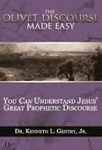
Olivet Discourse Made Easy (by Ken Gentry)
Verse-by-verse analysis of Christ’s teaching on Jerusalem’s destruction in Matt 24. Shows the great tribulation is past, having occurred in AD 70, and is distinct from the Second Advent at the end of history.
See more study materials at: www.KennethGentry.com
Matthew 20:17–19
“As Jesus was about to go up to Jerusalem, He took the twelve disciples aside by themselves, and on the way He said to them, ‘Behold, we are going up to Jerusalem; and the Son of Man will be delivered to the chief priests and scribes, and they will condemn Him to death, and will hand Him over to the Gentiles to mock and scourge and crucify Him, and on the third day He will be raised.’”
Here he explains that not only will he die, but his death will be an aggravated suffering. He will be mocked and scourged! And that by Gentiles! And what does the context of this passion announcement record for us — immediately? Matthew’s narrative strategy has him immediately record for us: “Then the mother of the sons of Zebedee came to Jesus with her sons, bowing down and making a request of Him. And He said to her, ‘What do you wish?’ She said to Him, ‘Command that in Your kingdom these two sons of mine may sit one on Your right and one on Your left’” (Matt. 20:20–21).
Clearly, the disciples simply were not “getting” Jesus’ teaching! He speaks of his approaching cruel death, but two of his disciples have their mother request a place of prominence for them in his kingdom! Though the mother of John and James asks the question, the other disciples are angry with John and James. This shows that the brothers were responsible for their mother’s request.
Have We Missed the Second Coming: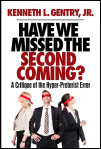
A Critique of the Hyper-preterist Error
by Ken Gentry
This book offers a brief introduction, summary, and critique of Hyper-preterism. Don’t let your church and Christian friends be blindfolded to this new error. To be forewarned is to be forearmed.
For more Christian educational materials: www.KennethGentry.com
Conclusion
In my book I will devote an entire chapter to the disciples’ tendency to misunderstand Jesus (e.g., Matt. 8:23–27; 15:15–20; 16:7–11; 16:16–23). This problem is noted by most scholars.[3] And recognizing this problem takes us a long way to seeing how they were confused in responding to Jesus’ prophecy of the coming destruction of the temple. In fact, the first thing Jesus says when the disciples ask him their two questions (Matt. 24:3) shows his concern with their tendency to confusion: “And Jesus answered and said to them, ‘See to it that no one misleads you’” (Matt. 24:4).
Today the semi-gnostic hyperpreterist movement is confusing scores of earnest Christians. Stumbling at the outset of the Olivet Discourse is one part of the problem.
Notes
1. I got this idea from a financial transaction I made in my 20s. I bought a motorcycle that sold for three easy payments and one incredibly hard payment. So I know how this easy/hard stuff works.
2. Though the Matthew 6:30 reference is taken from the Sermon on the Mount, Jesus is expressly teaching his disciples. For the Sermon opens with this announcement about the setting: “When Jesus saw the crowds, He went up on the mountain; and after He sat down, His disciples came to Him. He opened His mouth and began to teach them, saying…” (Matt. 5:1–2). However, apparently many in the crowds followed and listened, for we read in Matthew 7:28: “When Jesus had finished these words, the crowds were amazed at His teaching.”
3. In Jeffrey Gibbs’, Jerusalem and Parousia (ch. 6) we find abundant material showing the dullness of the disciples even in their question in Matt. 24:3: “In general terms, then, the ‘track record’ of the disciples in Matthew’s story signals the implied reader to distance himself or herself from the eschatological point of view reflected in the disciples’ double question of 24:3….” And “simply put … the disciples in Matthew’s Gospel consistently ‘get it wrong,’ both in general and specifically with respect to eschatological realities” (p. 180). Thus, in his study of another Gospel, R. T. France notes that “Mark’s irreverent portrayal of the disciples as dull-witted and slow to understand is often noticed.” He observes that after Jesus’ announcement of his death, it is “immediately followed by a response from the disciples which reveals their complete failure to come to terms with what Jesus is saying” (Divine Government, p. 49). Jeannine K. Brown wrote her entire doctoral dissertation on Matthew’s presentation of the disciples’ continual confusion: The Disciples in Narrative Perspective: The Portrayal and Function of the Matthean Disciples (Leiden, Netherlands: Brill, 2002). See also: David E. Garland, A Theology of Mark’s Gospel: Biblical Theology of the New Testament (Grand Rapids: Zondervan Academic, 2015), ch. 9 and Kik, Eschatology of Victory, 84ff. If you do not believe them, just ask me!
 Why I Left Full-Preterism (by Samuel M. Frost)
Why I Left Full-Preterism (by Samuel M. Frost)
Former leader in Full Preterist movement, Samuel M. Frost, gives his testimony and theological reasoning as to why he left the heretical movement. Good warning to others tempted to leave orthodox Christianity.
See more study materials at: KennethGentry.com
February 16, 2024
ABRAHAMIC COVENANT & THE LAND
 PMW 2024-013 by Kenneth L. Gentry, Jr.
PMW 2024-013 by Kenneth L. Gentry, Jr.
A quick summation of Genesis 12 and 13 regarding the precovenantal promise of God to Abraham.
Gen. 12:1a
Now the LORD said to Abram
At this point the Genesis narrative moves out of primeval history and into patriarchal history toward which it has been heading since Gen. 1:1. Like Adam and Noah before him, Abraham initiates a new beginning in advancing God’s plan in history. Although the Abrahamic Covenant will not be established until a little later (15:17–21), here we have the pre-covenantal promise that leads to it. God speaks to Abraham through direct, objective revelation (cp. Gen. 12:7; 17:1; 18:1; Acts 7:2).
Gen. 12:1b
go forth from your country
God called Abraham out of a pagan environment, for his father Terah was an idolater (Josh. 24:2, 15). The strength of Abraham’s faithfulness in answering God’s call is indicated from several factors: (1) He obeyed God, (2) without hesitation, (3) and to the point of leaving his family (v. 1), (4) even though he did not know yet where he was headed (“to a land I will show you,” cp. Heb. 11:8; cp. Heb. 11:1), and (5) while expecting God would make a great nation from him (v. 2) even though his wife was barren (11:30). True faith believes God’s word and submits to it. In Scripture Abraham serves as the very model of faith (Gen. 15:6; Rom. 4:3, 16; Gal. 3:6; Jms. 2:23).
 The Lord’s Prayer (8 mp3 sermons)
The Lord’s Prayer (8 mp3 sermons)
Eight part expository sermon series covering each element in the Lord’s Prayer. Very practical; very theological. Shows the glory of God, in his sovereignty as prayer underscores the victory of his kingdom and the rule of his law in history. Excellent postmillennial resource from this beloved prayer.
See more study materials at: www.KennethGentry.com
Gen. 12:2
make you a great nation
At the Tower of Babel, technologically-advanced men (11:3–4) failed in their attempt to make a name for themselves (11:4b). But here in v. 2 God promises to make a “great nation” out of this one man and his barren wife (11:30; 16:1). By God’s grace Abraham will multiply greatly (Gen. 15:5; 22:17; 26:4; Exo. 32:13; Deut. 1:10; 10:22). God is setting apart Abraham and his descendants to be a special nation (Exo. 19:5; Deut. 4:20; 7:6; 14:2; 26:18). National Israel leads to and will find her fulfillment in the New Testament multi-national church, “the Israel of God” (Gal. 6:15–16; cp. Gal. 3:29; Phil. 3:3; 1 Pet. 2:9).
Gen. 12:3
all the families of the earth
In Genesis 1:27 God created Adam as his image to exercise righteous dominion in the whole earth. Then immediately upon the fall of Adam, God promised that the “seed of the woman” would crush “the seed of the serpent” in history (3:15). Now God promises that through Abraham “all the families of the earth will be blessed” (cp. Gen. 22:18; 26:4; 28:14; Acts 3:25; Gal. 3:8). Interestingly, the grammar subtly suggests that a greater number of people will be blessed than cursed: compare the “one” (singular) who curses Abraham with “those” (plural) who bless him. Throughout Scripture this hope of a world-conquering faith will continue (Psa. 67:2; 72:17; 86:9; Isa. 66:18; Matt. 28:18–20; John 1:29; 3:17; 12:32; 1 John 2:2). The significance of the “seed” is an important theme in Genesis as we see in its toledoth (genealogy) reports (2:4; 5:1; 6:9; 10:1; 11:10, 27; 25:12, 19; 36:1; 37:2). As Genesis closes, we finally learn that the ultimate seed will be an individual to whom will be the “obedience of the peoples” (49:8–12). This one is Jesus Christ (Gal. 3:16; cp. Matt. 1:1; Luke 3:32–34), the Redeemer of mankind (John 1:29; 3:16–17; 4:42).
Major Bible Prophecies (5 mp3 lectures)
Gentry conference lectures on the Millennium, Daniel’s 70 Weeks,
Man of Sin, Heaven, and Unfulfilled Prophecies.
See more study materials at: www.KennethGentry.com
Gen. 13:14–15
In this context God promises that he will give the land to Abraham’s descendants “forever” (cp. 12:7). This will soon be confirmed by solemn covenant (cp. 15:7, 18) and is noted elsewhere in Scripture (Exo. 32:13; Josh. 14:9; 2 Chron. 20:7; Isa. 60:21).
Since “the earth is the LORD’s, and all it contains, / The world, and those who dwell in it” (Psa. 24:1), as Moses well knows (Exo. 9:29; Deut. 10:14), the land is God’s to give to whomever he pleases. Besides this, the evil Canaanite culture would eventually (15:16) justify God’s expelling them from the land (Lev. 18:2–3, 24–28 and Deuteronomy — Introduction — Special Issues).
The “forever” nature of this promise must be understood in terms of both the lexical significance of the Hebrew “forever,” the moral sanctions involved in God’s covenant, and the typological function of Old Testament redemptive history.
First, lexically, the Hebrew word translated “forever” is olam. It does not necessarily indicate unending perpetuity, but may represent a long period of time. For instance, it applies to the Old Testament sacrificial system, as in the practice of the Passover (which was fulfilled in Christ, Exo. 12:14, 17, 24), the continuation of offerings for the Aaronic priesthood (which has long since vanished, Exo. 29:28; cp. Exo. 40:15; Num. 25:13), and the permanence of the temple (which was fulfilled in Christ and destroyed in AD 70, 2 Chron. 7:16).
Clearly these samples of “forever” do not speak of unending duration, not even until the end of temporal history. This is further confirmed when “forever” speaks of the permanent status in Israel of a slave who wants to remain with his master’s house (Exo. 21:6) and the memorial stones set up by Joshua (Josh. 4:7).
Calvin observes regarding the language here that “in promising the land ‘for ever,’ he does not simply denote perpetuity; but that period which was brought to a close by the advent of Christ.” He adds, “the change which Christ introduced was not the abolition of the old promises, but rather their confirmation.” All of this fits perfectly with the typological nature of the Old Testament, which finds its fulfillment in the New.
Second, covenantally the Lord gives this land to Abraham in terms of a formal covenant transaction (15:12–20), not as a simple gift without any obligations or breach-of-covenant sanctions.
This is evident in that God often warns Israel that she may lose the land if she breaks covenant with him: Israel is warned that she must obey him “so that the land will not spew you out, should you defile it, as it has spewed out the nation which has been before you” (Lev. 18:28). Indeed, in the great covenant blessing and curse chapter, we find that it draws near to its conclusion warning: “It shall come about that as the LORD delighted over you to prosper you, and multiply you, so the LORD will delight over you to make you perish and destroy you; and you will be torn from the land where you are entering to possess it” (Deut. 28:63).
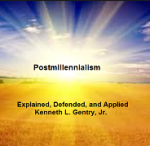 Postmillennialism Explained, Defended and Applied (6 mp3 lectures)
Postmillennialism Explained, Defended and Applied (6 mp3 lectures)
by Ken Gentry
These five lectures explain the biblical foundations to postmillennialism, while providing practical applications for the modern Christian.
See more study materials at: www.KennethGentry.com
Third, typologically the Promised Land serves as a type of the whole earth. As such, it pictures the spiritual rest brought by Christ’s kingdom, which shall cover the earth (see Heb. 3–4). We see this, for instance, in Psalm 37:11, which speaks of God’s promise to his people: “But the meek shall inherit the land.” Yet in Matt. 5:5 Jesus expands this very promise to include the entire earth. Also Abraham apparently understood the land promise as a down payment representing his inheriting the whole world (Rom. 4:13). Paul expands the land promises to extend across all the earth, when he draws them into the New Testament (e.g., Eph. 6:3).
In the unfolding story of redemption in the Old Testament, we see the expanding of the land promises: God gives Adam a garden (2:8); he grants Abraham’s seed a country (Josh. 1); he promises the New Covenant church the world (Matt. 28:18–20). Ultimately, in fact, Hebrews 11:8–16 shows that the land received by Abraham was not his ultimate longing. Rather, he understood it as referring to the eternal city of God’s kingdom (Gal. 4:26; Heb. 12:22–29).
February 13, 2024
ISRAEL AND GOD’S PEOPLE (3)
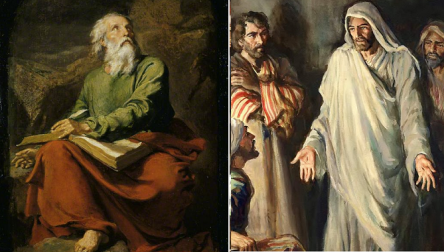 PMW 2024-012 by Kenneth L. Gentry, Jr.
PMW 2024-012 by Kenneth L. Gentry, Jr.
(Note: This article should have appeared last week. Unfortunately, I clicked on the wrong date for displaying it. So you are now reading the third article in a series after already reading the fourth one! Sorry about that. It’s Trump’s fault.)
I have offered two articles on Israel in my two previous installments of this study. I am currently rebutting the dispensational view of Scripture and theology, which presents a Judeo-centric focus. I will continue with my critique.
4. The new covenant church is not a mystery wholly unrevealed
Based on Ephesians 3, dispensationalist argue that the new covenant era, international church was a mystery that is “completely unrevealed in the Old Testament.” Certainly the clarity of the revelation of God’s expanding people increases in the New Testament. But that revelation was, in fact, given in the Old Testament.
Let’s look at dispensationalism’s key passage for this concept. Ephesians 3:5–6 reads: “which in other generations was not made known to the sons of men, as it has now been revealed to His holy apostles and prophets in the Spirit; to be specific, that the Gentiles are fellow heirs and fellow members of the body, and fellow partakers of the promise in Christ Jesus through the gospel.” We have already seen that the Old Testament anticipated this. Now we must note that Ryrie and the dispensationalists misread Paul’s statement. Consider the following.
To begin with, we must discern for whom the revelation was a mystery. Ephesians 3:3–6 reads: “By revelation he made known unto me the mystery . . . which in other ages was not made known unto the sons of men.” Thus, the “mystery” now revealed was not previously made known to the “sons of men,” that is, the Gentiles. It was made known to the “sons of Israel” through their prophets. The phrase “sons of Israel” appears often in the Old Testament (e.g., Exo 3:3, 14–15; 4:31; 5:14–15; 6:5; etc.), setting them over against the rest of the world, the Gentiles, the “sons of men.” When God speaks to Ananias he distinguishes between “the Gentiles” and “the sons of Israel” (Acts 9:15; cp. Luke 2:32; Acts 4:27).
This is made indisputably clear in Romans 16:25–26. There Paul points out that the “mystery” of Gentile salvation is hidden only from the Gentiles, not from the Old Testament prophets — for he defends his doctrine of the mystery by referring to “the scriptures of the prophets”: “the revelation of the mystery, which was kept secret since the world began, but now is made manifest, and by the scriptures of the prophets, according to the commandment of the everlasting God, made known to all nations for the obedience of faith.” Paul declares that the “mystery” is “now made manifest” to “all nations” — not just to Israel.
Thine Is the Kingdom
(ed. by Ken Gentry)
Contributors lay the scriptural foundation for a biblically-based, hope-filled postmillennial eschatology, while showing what it means to be postmillennial in the real world.
See more study materials at: www.KennethGentry.com
5. The new covenant unites Jew and Gentile into one body
Paul teaches us that Gentile Christians of the new covenant church are grafted into the stock of Israel (Rom 11:16–19). Indeed, we are united with the patriarchs of the old covenant, even while many ethnic Jews are cut out of the kingdom of God: “if some of the branches were broken off, and you, being a wild olive, were grafted in among them and became partaker with them of the rich root of the olive tree, do not be arrogant toward the branches; but if you are arrogant, remember that it is not you who supports the root, but the root supports you” (Rom 11:17–18). God’s people are symbolized by one tree, not two.
Furthermore, Paul expressly declares that Christ’s death wholly removes the wall of separation between Jew and Gentile, merging them into one: “He Himself is our peace, who made both groups into one, and broke down the barrier of the dividing wall” (Eph 2:14). Nothing hints that this great redemptive truth is temporary and will be removed later in the millennium, as per dispensational teaching.
In fact, the “cementing” agent in this union is the powerful blood of Christ: “But now in Christ Jesus you who formerly were far off have been brought near by the blood of Christ” (Eph 2:13). Consequently, he was “abolishing [not temporarily halting] in His flesh the enmity” that separated Jew and Gentile (Eph 2:15). This comports well with what Christ teaches when he presents himself as the Good Shepherd in John 10:16: “And I have other sheep [Gentiles] which are not of this fold; I must bring them also, and they shall hear My voice; and they shall become one flock with one shepherd.”
Dispensationalism demands two groups and thus attempts to repair the barrier wall that Christ broke down as they make two people out of those whom Christ has made one. Whereas, the more biblical position would be to affirm: “What God has joined together, let no man separate.”
6. The new covenant church is called Abraham’s seed
Israel’s biological descent from Abraham was a source of great Jewish pride. God is often called in Scripture “the God of Abraham” (Gen 28:13; 31:42, 53; Exo 3:6, 15–16; 4:5; 1 Kgs 18:36; 1 Chron 29:18; 2 Chron 30:6; Psa 47:9; Matt 22:32; Mark 12:36; Luke 20:37; Acts 3:13; 7:32). Because he is “the God of Abraham” the Jews expected blessings in terms of their Abrahamic descent (Matt 3:9; 8:11; Luke 3:8; 13:16, 28; 16:23–30; 19:9; John 8:39, 53; Rom 11:1; 2 Cor 11:22). Yet in the new covenant, Gentile Christians are called the children of Abraham.
We see this in Galatians where Paul writes: “therefore, be sure that it is those who are of faith who are sons of Abraham. And the Scripture, foreseeing that God would justify the Gentiles by faith, preached the gospel beforehand to Abraham, saying, ‘All the nations shall be blessed in you’”(Gal 3:7–8). Then a few verses later he forthrightly declares: “if you belong to Christ, then you are Abraham’s offspring, heirs according to promise” (Gal 3:29).
Three Views on the Millennium and Beyond
(ed. by Darrell Bock)
Presents three views on the millennium: progressive dispensationalist, amillennialist, and reconstructionist postmillennialist viewpoints. Includes separate responses to each view. Ken Gentry provides the postmillennial contribution.
See more study materials at: www.KennethGentry.com
7. The new covenant church sees old covenant Israel as their “fathers”
Following up on the redemptive truth regarding our being children of Abraham, we discover also that new covenant Gentile Christians call Abraham “our father” (Rom 4:16). Paul can even call the old covenant patriarchs “our fathers” (1 Cor 10:1), clearly evincing a spiritual relationship uniting the new covenant people with the old covenant people, related as a seed to its fruit.
8. The new covenant church is given Jewish titles and descriptions
Scripture frequently applies old covenant terms to new covenant citizens: we are the “the circumcision” (Rom 2:28–29; Phil 3:3; Col 2:11; cp. Gen 17:13; Acts 7:8), “a royal priesthood,” (Rom 15:16; 1 Pet 2:9; Rev 1:6; 5:10; cp. Exo 19:6), and the “temple of God” (1 Cor 3:16–17; 6:19; 2 Cor 1:16; Eph 2:21). These terms clearly reflect Israel’s covenantal identity, but are applied to the new covenant people.
Peter piles up some of these Old Testament designations and others applying them to the church. He calls Christians: “a chosen generation, a royal priesthood, an holy nation” (1 Pet 2:9–10), which is based on Exodus 19:5–6 and Deuteronomy 7:6. He and Paul call Christians “a peculiar people” (1 Pet 2:10; Tit 2:14), which is a familiar Old Testament designation for Israel (Exo 19:5; Deut 14:2; 26:18; Psa 135:4).
To be continued in my next and final study.
Click on the following images for more information on these studies:



ISRAEL AND GOD’S PEOPLE (4)
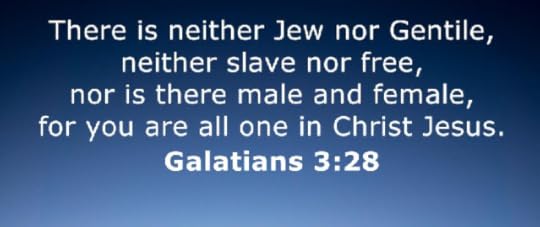 This is my final installment on a brief series of the role of Israel in the Bible and theology. I am responding to the Judeo-centric theology of dispensationalism. Please read the three preceding articles to understand the flow of my argument. I now move on to note that:
This is my final installment on a brief series of the role of Israel in the Bible and theology. I am responding to the Judeo-centric theology of dispensationalism. Please read the three preceding articles to understand the flow of my argument. I now move on to note that:
9. The new covenant church is actually called “Israel”
Dispensationalists strongly resist the application of “Israel” to the church, asserting that “the Scriptures never use the term Israel to refer to any but the natural descendants of Jacob” [1] But if according to the New Scofield Reference Bible Abraham can have Gentiles as his “spiritual seed,” [2] why may we not envision a spiritual Israel?
In fact, Paul applies the name “Israel” to Christians when he writes: “And as many as walk according to this rule, peace and mercy be upon them, and upon the Israel of God” (Gal 6:16). Here he is referring to Christians as “the Israel of God.” In the Greek the “and “preceding “the Israel of God,” functions epexegetically. That is, we should translate the verse “peace and mercy upon them, that is, upon the Israel of God.” Thus, according to Paul “as many as walk according to this rule [Christian faith]” are the “Israel of God.”
Dispensationalists see Galatians 6:16 as applying to Jewish converts to Christ, “who would not oppose the apostle’s glorious message of salvation.” [3] But such is surely not the case, for the following reasons. The entire epistle of Galatians opposes any claim to a special Jewish status or distinction: “For you are all sons of God through faith in Christ Jesus. For as many of you as were baptized into Christ have put on Christ. There is neither Jew nor Greek, there is neither slave nor free, there is neither male nor female; for you are all one in Christ Jesus” (Gal 3:26–28).
So here Paul declares that in the new covenant Christ does away with all ethnic distinctions. Why would he hold out a special word for Jewish Christians as “the Israel of God,” when he states immediately beforehand that we must not boast at all, save in the cross of Christ (Gal 6:14)? In fact, “in Christ Jesus neither circumcision nor uncircumcision avails anything, but a new creation” (Gal 6:15). Elsewhere, Paul can even speak of an uncircumcised Gentile as “a Jew who is one inwardly” whose “circumcision is that which is of the heart” (Rom 2:28–29).
Tongues-speaking: Meaning, Purpose, and Cessation
 by Ken Gentry
by Ken Gentry
The position presented within is that tongues-speaking allowed the gift person to speak in a known human language without previously knowing it; tongues brought inspired revelation from God; the gift was a sign confirming the apostolic witness and warning of the coming destruction of Jerusalem; and therefore the gift ceased in the first century.
See more study materials at: www.KennethGentry.com
10. The new covenant removes all ethnic distinctions
In several places Paul drives home the point that the days of ethnic distinction in God’s kingdom are over with. “There is neither Jew nor Greek . . . for you are all one in Christ” (Gal 3:28). “There is no distinction between Greek and Jew, circumcised and uncircumcised” (Col 3:11). “For there is no distinction between Jew and Greek; for the same Lord is Lord of all, abounding in riches for all who call upon Him” (Rom 10:12). This principle of “neither Jew nor Greek” explains why the Old Testament promises and prophecies can apply to Gentile Christians and the pan-ethnic new covenant church. It also explains why we should not re-impose ethnic distinctions in our doctrine of the church.
Conclusion
Old Testament Israel was long the special, singular people of God. Dispensationalism is built on the view that she remains God’s special people and will one day come again to prominence in God’s dealings with man. In fact, the system is firmly rooted in the notion that Israel and the church must remain distinct. We have seen, though, that the Old Testament expected the expansion of Israel and that the New Testament speaks repeatedly of that expansion in such a way that we may see that the church is the new Israel.
NOTES
1. Charles L. Feinberg, Millennialism: The Two Major Views (3rd ed. Chicago: Moody, 1980), 230. “The term Israel is nowhere used in the Scriptures for any but the physical descendants of Abraham.” Pentecost, Things to Come, 127.
2. New Scofield Reference Bible, 1223 (at Rom 9:6).
3. New Scofield Reference Bible, 1223.
The Truth about Postmillennialism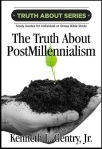 By Ken Gentry
By Ken Gentry
A group Bible study guide for explaining the optimistic prophetic hope for this world to be accomplished before Christ’s Second Coming. Establishes the postmillennial system in both the Old and New Testaments. Touches on key eschatological issues, such as creation, covenant, interpretive methodolgy, the great tribulation, the Book of Revelation, the Jewish Temple, and more. It presents and answers the leading objections to postmillennialism.Twelve chapters are ideal for one quarter of Sunday School.
See more study materials at: www.KennethGentry.com
February 9, 2024
ISRAEL AND GOD’S PEOPLE (3)
 PMW 2024-012 by Kenneth L. Gentry, Jr.
PMW 2024-012 by Kenneth L. Gentry, Jr.
I have offered two articles on Israel in my two previous installments of this study. I am currently rebutting the dispensational view of Scripture and theology, which presents a Judeo-centric focus. I will continue with my critique.
4. The new covenant church is not a mystery wholly unrevealed
Based on Ephesians 3, dispensationalist argue that the new covenant era, international church was a mystery that is “completely unrevealed in the Old Testament.” Certainly the clarity of the revelation of God’s expanding people increases in the New Testament. But that revelation was, in fact, given in the Old Testament.
Let’s look at dispensationalism’s key passage for this concept. Ephesians 3:5–6 reads: “which in other generations was not made known to the sons of men, as it has now been revealed to His holy apostles and prophets in the Spirit; to be specific, that the Gentiles are fellow heirs and fellow members of the body, and fellow partakers of the promise in Christ Jesus through the gospel.” We have already seen that the Old Testament anticipated this. Now we must note that Ryrie and the dispensationalists misread Paul’s statement. Consider the following.
To begin with, we must discern for whom the revelation was a mystery. Ephesians 3:3–6 reads: “By revelation he made known unto me the mystery . . . which in other ages was not made known unto the sons of men.” Thus, the “mystery” now revealed was not previously made known to the “sons of men,” that is, the Gentiles. It was made known to the “sons of Israel” through their prophets. The phrase “sons of Israel” appears often in the Old Testament (e.g., Exo 3:3, 14–15; 4:31; 5:14–15; 6:5; etc.), setting them over against the rest of the world, the Gentiles, the “sons of men.” When God speaks to Ananias he distinguishes between “the Gentiles” and “the sons of Israel” (Acts 9:15; cp. Luke 2:32; Acts 4:27).
This is made indisputably clear in Romans 16:25–26. There Paul points out that the “mystery” of Gentile salvation is hidden only from the Gentiles, not from the Old Testament prophets — for he defends his doctrine of the mystery by referring to “the scriptures of the prophets”: “the revelation of the mystery, which was kept secret since the world began, but now is made manifest, and by the scriptures of the prophets, according to the commandment of the everlasting God, made known to all nations for the obedience of faith.” Paul declares that the “mystery” is “now made manifest” to “all nations” — not just to Israel.
Thine Is the Kingdom
(ed. by Ken Gentry)
Contributors lay the scriptural foundation for a biblically-based, hope-filled postmillennial eschatology, while showing what it means to be postmillennial in the real world.
See more study materials at: www.KennethGentry.com
5. The new covenant unites Jew and Gentile into one body
Paul teaches us that Gentile Christians of the new covenant church are grafted into the stock of Israel (Rom 11:16–19). Indeed, we are united with the patriarchs of the old covenant, even while many ethnic Jews are cut out of the kingdom of God: “if some of the branches were broken off, and you, being a wild olive, were grafted in among them and became partaker with them of the rich root of the olive tree, do not be arrogant toward the branches; but if you are arrogant, remember that it is not you who supports the root, but the root supports you” (Rom 11:17–18). God’s people are symbolized by one tree, not two.
Furthermore, Paul expressly declares that Christ’s death wholly removes the wall of separation between Jew and Gentile, merging them into one: “He Himself is our peace, who made both groups into one, and broke down the barrier of the dividing wall” (Eph 2:14). Nothing hints that this great redemptive truth is temporary and will be removed later in the millennium, as per dispensational teaching.
In fact, the “cementing” agent in this union is the powerful blood of Christ: “But now in Christ Jesus you who formerly were far off have been brought near by the blood of Christ” (Eph 2:13). Consequently, he was “abolishing [not temporarily halting] in His flesh the enmity” that separated Jew and Gentile (Eph 2:15). This comports well with what Christ teaches when he presents himself as the Good Shepherd in John 10:16: “And I have other sheep [Gentiles] which are not of this fold; I must bring them also, and they shall hear My voice; and they shall become one flock with one shepherd.”
Dispensationalism demands two groups and thus attempts to repair the barrier wall that Christ broke down as they make two people out of those whom Christ has made one. Whereas, the more biblical position would be to affirm: “What God has joined together, let no man separate.”
6. The new covenant church is called Abraham’s seed
Israel’s biological descent from Abraham was a source of great Jewish pride. God is often called in Scripture “the God of Abraham” (Gen 28:13; 31:42, 53; Exo 3:6, 15–16; 4:5; 1 Kgs 18:36; 1 Chron 29:18; 2 Chron 30:6; Psa 47:9; Matt 22:32; Mark 12:36; Luke 20:37; Acts 3:13; 7:32). Because he is “the God of Abraham” the Jews expected blessings in terms of their Abrahamic descent (Matt 3:9; 8:11; Luke 3:8; 13:16, 28; 16:23–30; 19:9; John 8:39, 53; Rom 11:1; 2 Cor 11:22). Yet in the new covenant, Gentile Christians are called the children of Abraham.
We see this in Galatians where Paul writes: “therefore, be sure that it is those who are of faith who are sons of Abraham. And the Scripture, foreseeing that God would justify the Gentiles by faith, preached the gospel beforehand to Abraham, saying, ‘All the nations shall be blessed in you’”(Gal 3:7–8). Then a few verses later he forthrightly declares: “if you belong to Christ, then you are Abraham’s offspring, heirs according to promise” (Gal 3:29).
Three Views on the Millennium and Beyond
(ed. by Darrell Bock)
Presents three views on the millennium: progressive dispensationalist, amillennialist, and reconstructionist postmillennialist viewpoints. Includes separate responses to each view. Ken Gentry provides the postmillennial contribution.
See more study materials at: www.KennethGentry.com
7. The new covenant church sees old covenant Israel as their “fathers”
Following up on the redemptive truth regarding our being children of Abraham, we discover also that new covenant Gentile Christians call Abraham “our father” (Rom 4:16). Paul can even call the old covenant patriarchs “our fathers” (1 Cor 10:1), clearly evincing a spiritual relationship uniting the new covenant people with the old covenant people, related as a seed to its fruit.
8. The new covenant church is given Jewish titles and descriptions
Scripture frequently applies old covenant terms to new covenant citizens: we are the “the circumcision” (Rom 2:28–29; Phil 3:3; Col 2:11; cp. Gen 17:13; Acts 7:8), “a royal priesthood,” (Rom 15:16; 1 Pet 2:9; Rev 1:6; 5:10; cp. Exo 19:6), and the “temple of God” (1 Cor 3:16–17; 6:19; 2 Cor 1:16; Eph 2:21). These terms clearly reflect Israel’s covenantal identity, but are applied to the new covenant people.
Peter piles up some of these Old Testament designations and others applying them to the church. He calls Christians: “a chosen generation, a royal priesthood, an holy nation” (1 Pet 2:9–10), which is based on Exodus 19:5–6 and Deuteronomy 7:6. He and Paul call Christians “a peculiar people” (1 Pet 2:10; Tit 2:14), which is a familiar Old Testament designation for Israel (Exo 19:5; Deut 14:2; 26:18; Psa 135:4).
To be continued in my next and final study.
Click on the following images for more information on these studies:



ISRAEL AND GOD’S PEOPLE (4)
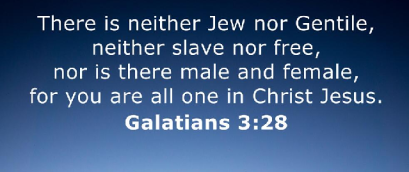 This is my final installment on a brief series of the role of Israel in the Bible and theology. I am responding to the Judeo-centric theology of dispensationalism. Please read the three preceding articles to understand the flow of my argument. I now move on to note that:
This is my final installment on a brief series of the role of Israel in the Bible and theology. I am responding to the Judeo-centric theology of dispensationalism. Please read the three preceding articles to understand the flow of my argument. I now move on to note that:
9. The new covenant church is actually called “Israel”
Dispensationalists strongly resist the application of “Israel” to the church, asserting that “the Scriptures never use the term Israel to refer to any but the natural descendants of Jacob” [1] But if according to the New Scofield Reference Bible Abraham can have Gentiles as his “spiritual seed,” [2] why may we not envision a spiritual Israel?
In fact, Paul applies the name “Israel” to Christians when he writes: “And as many as walk according to this rule, peace and mercy be upon them, and upon the Israel of God” (Gal 6:16). Here he is referring to Christians as “the Israel of God.” In the Greek the “and “preceding “the Israel of God,” functions epexegetically. That is, we should translate the verse “peace and mercy upon them, that is, upon the Israel of God.” Thus, according to Paul “as many as walk according to this rule [Christian faith]” are the “Israel of God.”
Dispensationalists see Galatians 6:16 as applying to Jewish converts to Christ, “who would not oppose the apostle’s glorious message of salvation.” [3] But such is surely not the case, for the following reasons. The entire epistle of Galatians opposes any claim to a special Jewish status or distinction: “For you are all sons of God through faith in Christ Jesus. For as many of you as were baptized into Christ have put on Christ. There is neither Jew nor Greek, there is neither slave nor free, there is neither male nor female; for you are all one in Christ Jesus” (Gal 3:26–28).
So here Paul declares that in the new covenant Christ does away with all ethnic distinctions. Why would he hold out a special word for Jewish Christians as “the Israel of God,” when he states immediately beforehand that we must not boast at all, save in the cross of Christ (Gal 6:14)? In fact, “in Christ Jesus neither circumcision nor uncircumcision avails anything, but a new creation” (Gal 6:15). Elsewhere, Paul can even speak of an uncircumcised Gentile as “a Jew who is one inwardly” whose “circumcision is that which is of the heart” (Rom 2:28–29).
Tongues-speaking: Meaning, Purpose, and Cessation
 by Ken Gentry
by Ken Gentry
The position presented within is that tongues-speaking allowed the gift person to speak in a known human language without previously knowing it; tongues brought inspired revelation from God; the gift was a sign confirming the apostolic witness and warning of the coming destruction of Jerusalem; and therefore the gift ceased in the first century.
See more study materials at: www.KennethGentry.com
10. The new covenant removes all ethnic distinctions
In several places Paul drives home the point that the days of ethnic distinction in God’s kingdom are over with. “There is neither Jew nor Greek . . . for you are all one in Christ” (Gal 3:28). “There is no distinction between Greek and Jew, circumcised and uncircumcised” (Col 3:11). “For there is no distinction between Jew and Greek; for the same Lord is Lord of all, abounding in riches for all who call upon Him” (Rom 10:12). This principle of “neither Jew nor Greek” explains why the Old Testament promises and prophecies can apply to Gentile Christians and the pan-ethnic new covenant church. It also explains why we should not re-impose ethnic distinctions in our doctrine of the church.
Conclusion
Old Testament Israel was long the special, singular people of God. Dispensationalism is built on the view that she remains God’s special people and will one day come again to prominence in God’s dealings with man. In fact, the system is firmly rooted in the notion that Israel and the church must remain distinct. We have seen, though, that the Old Testament expected the expansion of Israel and that the New Testament speaks repeatedly of that expansion in such a way that we may see that the church is the new Israel.
NOTES
1. Charles L. Feinberg, Millennialism: The Two Major Views (3rd ed. Chicago: Moody, 1980), 230. “The term Israel is nowhere used in the Scriptures for any but the physical descendants of Abraham.” Pentecost, Things to Come, 127.
2. New Scofield Reference Bible, 1223 (at Rom 9:6).
3. New Scofield Reference Bible, 1223.
The Truth about Postmillennialism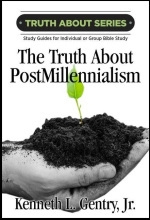 By Ken Gentry
By Ken Gentry
A group Bible study guide for explaining the optimistic prophetic hope for this world to be accomplished before Christ’s Second Coming. Establishes the postmillennial system in both the Old and New Testaments. Touches on key eschatological issues, such as creation, covenant, interpretive methodolgy, the great tribulation, the Book of Revelation, the Jewish Temple, and more. It presents and answers the leading objections to postmillennialism.Twelve chapters are ideal for one quarter of Sunday School.
See more study materials at: www.KennethGentry.com
February 6, 2024
ISRAEL AND GOD’S PEOPLE (2)
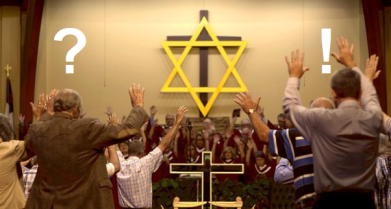 PMW 2024-011 by Kenneth L. Gentry, Jr.
PMW 2024-011 by Kenneth L. Gentry, Jr.
In my opening installment of this four-part series on Israel, I highlighted the wildly popular dispensational view of Israel, which has a Judeo-centric eschatology. My reader should consult my preceding article in order to understand what I am arguing.
Continuing the idea of the previous article, I would note that though “replacement theology” is a popular charge against non-dispensational, evangelical theology, a better term would be: “fulfillment theology.” Let me demonstrate the biblical warrant for this “fulfillment theology” view.
1. The OT anticipates the expansion of God’s people
The Old Testament writers foresee a time in which God will expand his people by bringing blessings on the Gentiles and including them within Israel. This hope is established early in Israel’s formative history when God establishes his covenant with Abraham: “As for Me, behold, My covenant is with you, / And you shall be the father of a multitude of nations” (Gen 17:4).
Perhaps the clearest and more remarkable expression of this appears in Isaiah 19:23–25. There we read that God will include Israel’s greatest enemies in his covenant:
“In that day there will be a highway from Egypt to Assyria, and the Assyrians will come into Egypt and the Egyptians into Assyria, and the Egyptians will worship with the Assyrians. In that day Israel will be the third party with Egypt and Assyria, a blessing in the midst of the earth, whom the Lord of hosts has blessed, saying, ‘Blessed is Egypt My people, and Assyria the work of My hands, and Israel My inheritance.’”
 “Jesus, Matthew, and the Rejection of Israel” (downloadable mp3)
“Jesus, Matthew, and the Rejection of Israel” (downloadable mp3)
by Ken Gentry
Surveys the Gospel of Matthew and highlights the numerous references — direct and indirect — that suggest that Matthew’s Gospel was written (at least in part) to demonstrate that God was rejecting Israel. A great many passages in Matthew are surveyed and briefly elaborated upon.
See more study materials at: http://www.KennethGentry.com
Zechariah expresses this hope by referring to Israel’s earliest enemy within the Promised Land:
“And a mongrel race will dwell in Ashdod, / And I will cut off the pride of the Philistines. / And I will remove their blood from their mouth, / And their detestable things from between their teeth. / Then they also will be a remnant for our God, / And be like a clan in Judah, / And Ekron like a Jebusite.” (Zech 9:6–7)
The conversion of the Gentiles in the new covenant is simply the fulfillment of these prophecies which adopt Israel’s enemies into her family.
2. The NT applies OT prophecies to the church
In Jeremiah 31:31 we read of God’s prophecy of the new covenant with Israel: “‘Behold, days are coming,’ declares the LORD, ‘when I will make a new covenant with the house of Israel and with the house of Judah.” Christ inaugurates this “new covenant” toward the end of his ministry as he establishes the New Testament phase of his church. During his Last Supper he states: “This cup which is poured out for you is the new covenant in My blood” (Luke 22:20).
Dispensationalist J. Dwight Pentecost is quite correct when he writes of Christ’s establishing the Lord’s Supper: “In its historical setting, the disciples who heard the Lord refer to the new covenant . . . would certainly have understood Him to be referring to the new covenant of Jeremiah 31.” [1] What could be more obvious? The prophecy of God’s new covenant with Israel applies to the New Testament church.
In fact, the sudden appearance of the “new covenant” in the New Testament record without qualification or explanation, demands that it refer to Jeremiah’s well-known new covenant (see: Matt 26:28; Mark 14:24; Luke 22:20; 1 Cor 11:25). Paul even promotes the new covenant as an important aspect of his ministry: God “also made us adequate as servants of a new covenant” (2 Cor 3:6). Thus, he is a minister of the new covenant even though he is the “apostle to the Gentiles” (Rom 11:13; cp. Acts 9:15; 22:21; 26:17; Rom 1:5; 15:16; Gal 1:16; 2:7; Eph 3:1, 8; 1 Tim 2:7; 2 Tim 4:7).
In Acts 15 James speaks of the conversion of the Gentiles as a fulfillment of a distinctively Jewish-sounding prophecy in Amos 9:11–12. James sees in the conversion of the Gentiles a rebuilding of “the tabernacle of David”:
“Simeon has related how God first concerned Himself about taking from among the Gentiles a people for His name. ‘And with this the words of the Prophets agree, just as it is written, “After these things I will return, / And I will rebuild the tabernacle of David which has fallen, / And I will rebuild its ruins, / And I will restore it, / In order that the rest of mankind may seek the Lord, / And all the Gentiles who are called by My name,” / Says the Lord, who makes these things known from of old.’” (Acts 15: 14–18)
Thus, he sees the converted Gentiles as entering the prophetic “tabernacle of David,” thereby sharing in this Jewish promise.
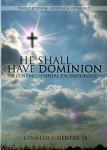
He Shall Have Dominion
(paperback by Kenneth Gentry)
A classic, thorough explanation and defense of postmillennialism (600+ pages). Complete with several chapters answering specific objections.
See more study materials at: www.KennethGentry.com
During her rebellion in the Old Testament, God promises “the sons of Israel” that “in the place / Where it is said to them, / ‘You are not My people,’ / It will be said to them, / ‘You are the sons of the living God’” (Hos 2:10b). Paul cites this glorious prophecy of inclusion in God’s family and directly applies it to the church:
“even us, whom He also called, not from among Jews only, but also from among Gentiles. As He says also in Hosea, ‘I will call those who were not My people, “My people,” / And her who was not beloved, “beloved.”’ / And it shall be that in the place where it was said to them, “you are not My people,” / There they shall be called sons of the living God.’” (Rom. 9:25–27)
3. The new covenant church receives OT promises
Not only do we learn that Old Testament prophecies regarding Israel are fulfilled in the church, but we even see that old covenant promises for Israel apply to the church. The new covenant church is the recipient of old covenant Israel’s blessings.
For instance, when Paul speaks to the Gentiles in Ephesians, he reminds them that “formerly” they were “at that time” in the past “strangers to the covenants of promise” (Eph 2:12). That is, in their past they were devoid of God’s “promise.” But this no longer is true!
Paul adds: “but now in Christ Jesus you who were formerly were far off have been brought near” (Eph 2:13). Interestingly, Paul is citing Isaiah 57:19, which was a promise of future blessing to Israel given though she was currently in sin. In Isaiah 56:1 through 66:24 Isaiah is focusing on the shame and glory of Zion, that is to be followed by her glory. Yet Paul applies a promise from Zion in Isaiah 57:19 to the Gentiles in Ephesus.
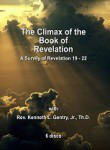 The Climax of the Book of Revelation (Rev 19-22)
The Climax of the Book of Revelation (Rev 19-22)
Six lectures on six DVDs that introduce Revelation as a whole, then focuses on its glorious conclusion. Provides an important, lengthy Introduction to Revelation also.
See more study materials at: www.KennethGentry.com
In Galatians 3:29 he refers to the foundational promise to Israel contained in the Abrahamic Covenant. He applies that promise to the Gentiles: “if you belong to Christ, then you are Abraham’s offspring, heirs according to promise.”
Dispensationalists teach that the new covenant church is an aside, an intercalation in God’s major plan, a parenthesis in the outworking of redemptive history. The New Testament, however, deems her the direct recipient of God’s full blessings.
To be continued.
NOTES
1. J. Dwight Pentecost, Things to Come: A Study in Biblical Eschatology (Grand Rapids: Zondervan, 1958), 126.
Click on the following images for more information on these studies:


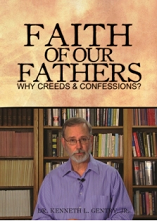
February 2, 2024
ISRAEL AND GOD’S PEOPLE (1)
 PMW 2024-010 by Kenneth L. Gentry, Jr.
PMW 2024-010 by Kenneth L. Gentry, Jr.
Because of the prominence of dispensationalism and the Left Behind phenomenon in evangelical circles, it is important for us to reflect on a fundamental emphasis in contemporary prophecy discussions: Israel. This is also important in that Israel does ver clearly play a prominent role in Scripture. In this brief series I will provide a brief study of the Scripture’s view of Israel from a Reformed perspective both exegetically and theologically
As all Christians know, throughout most of the Old Testament Israel is God’s special people — beginning in seed form with the calling of Abraham in Genesis 12. She is God’s elect nation (Deut 7:7–8 ; 10:15; Zech 2:8; Rom 3:1–3; 11:1) and the focal point of his redemptive mercies in history (Deut 4:7–8; Psa 147:19–20; Amos 3:2; Rom 9:4). Because of her commanding presence in old covenant history and her central role in Old Testament prophecy she becomes a crucial issue in understanding the Bible.
Israel in the Bible and History (9 mp3 lectures)
by Ken Gentry
The people of Israel are the people of God. But the modern church is divided over the nature, call and identity of Israel. This lecture series covers key issues for understanding the biblical concept of Israel.
See more study materials at: www.KennethGentry.com
Dispensationalism’s Error Presented
Perhaps the leading distinctive of dispensational theology is that ethnic Israel remains God’s key and favored people who will continue to star in his major plan for history. This view of Israel involves dispensationalism in its most destructive error. All of dispensational theology orbits around Israel as its theological center of gravity.
Two of the most destructive results of dispensationalism’s error regarding Israel are: (1) Its view of Israel destroys the unity of God’s people by creating two peoples of God in history (Israel and the church). (2) Its prophetic expectation built on Israel lowers the status of the church (by exalting geo-political Israel) and retrogressively re-institutes blood sacrifices as history’s final and highest redemptive period (the millennium).
Let us focus briefly on this error as explicated by dispensationalism’s leading scholar, Charles C. Ryrie. Ryrie points to the centrality and exaltation of Israel as the first of the three essential elements of dispensationalism: “A dispensationalist keeps Israel and the Church distinct.” [1] He defends this position over against all other evangelical theologies by arguing that:
“(1) The Church is not fulfilling in any sense the promises to Israel. (2) The use of the word Church in the New Testament never includes unsaved Israelites. (3) The Church Age is not seen in God’s program for Israel. It is an intercalation. (4) The Church is a mystery in the sense that it was completely unrevealed in the Old Testament and now revealed in the New Testament. (5) The Church did not begin until the day of Pentecost and will be removed from this world at the rapture which precedes the Second Coming of Christ.” [2]
Unfortunately, each one of Ryrie’s points is mistaken. As a result, the dispensational house is built on sinking sand. Let us see how this is so.
Dispensationalism’s Error Demonstrated
Scripture does not support Ryrie’s distinctive assertions, which are absolutely fundamental to the dispensational system. Rather, it teaches that old covenant Israel is the seed of God’s people which flowers in history, becoming the expanded, global people of God in the new covenant Church.
Some call this view “replacement theology” and fear that this position altogether removes Israel from God’s plan and replaces her with a new and distinct people. But a better description would be to call it “fulfillment theology.” That is, this view understands the new covenant as expanding God’s people from a single ethnic people embodied in a geo-political structure to a pan-ethnic people embodied in a new structure, the new, true, spiritual, covenant Church.
House Divided: The Break-up of Dispensational Theology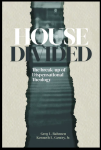 By Greg Bahnsen and Ken Gentry
By Greg Bahnsen and Ken Gentry
This book presents and defends Christian Reconstruction theology, particularly theonomic ethics and postmillennial eschatology. It does to by responding to dispensationalism’s social and exegetical theology.
For more educational materials: www. KennethGentry.com
The more common evangelical and Reformed view of the oneness of God’s people recognizes old covenant Israel as the actual people of God in the Old Testament. They function as the seed of the coming global people of God in the New Testament. As the Westminster Confession of Faith (written in the 1640s) expresses it, Israel is “a church under age” (WCF 19:3).
Stay tuned. I will continue this four-part series in my next installment.
NOTES
1. Charles C. Ryrie, Dispensationalism (2d. ed.: Chicago: Moody, 1995), 39.
Charles C. Ryrie, The Basis of the Premillennial Faith, (Neptune, N. J.: Loizeaux, 1953), 136.
Click on the following images for more information on these studies:


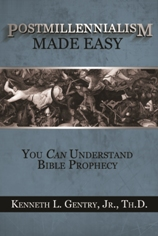
January 30, 2024
EFFECTIVE BIBLE NOTATION
PMW 2024-009 by Kenneth L. Gentry, Jr.

Postmillennialists are a people of the Book. We are certainly note people of the Newspapers (dispensationalists argue that current news is contra postmillennialism). So, as committed Christians we are Bible-believing Christians (1 Thess. 2:13). We believe we are sanctified by the Word of truth (John 17:17). We understand that we must diligently feed upon the solid meat of Scripture (Heb. 5:12-14). We happily examine the words of ministers with great eagerness, searching the Scriptures to see whether these things are so (Acts 17:11). Consequently, a sign of the committed Christian is his or her well-marked Bible.
I am sure my experience has been that of the vast majority of Bible-carrying, text-marking Christians: I often regret having too hastily jotted indelible notes in my favorite expensive, leather-bound Bible. I still have the first Bible I received upon my conversion at age 16. Needless to say, I have plenty of notes in that Bible that I lament.
Over the years, therefore, I have begun being more careful in my note-taking while listening to sermons and lectures on Scripture. I would like to share a few thoughts that have enhanced my note-taking and limited the number of Bibles I have had to toss out. This article is basically a brief, random collection of a few ideas on Bible marking, some with more explanation and illustration than others.
Tools of the Trade
The first order of business in your bibliocharagmic (Bible marking) endeavor is to purchase proper tools for the trade. Important tools include the following (none of them gasoline powered, harmful to the environment, or high on calories):
First, a good quality wide-margin Bible. More ample margins provide additional space for serious, orderly note-taking. This important tool not only provides more notes ready to hand, but facilitates later deciphering of them. You do not need to purchase a Bible all constructed of acacia wood two and a half cubits long, and one and a half cubits wide, and one and a half cubits high. A good wide-margin Bible provides one inch margins all around while remaining a manageable size.
Nourishment from the Word (by Ken Gentry)
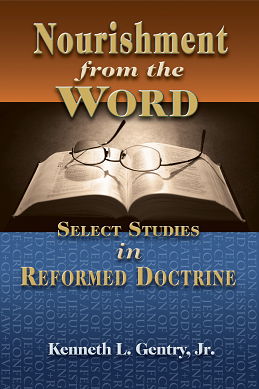
Reformed studies covering important theological topics: baptism, creation, creeds, tongues, God’s law, apologetics, and the Book of Revelation.
See more study materials at: www.KennethGentry.com
Second, a mechanical pencil. I highly recommend taking notes with a mechanical pencil, rather than ball point pen. I prefer a pencil with either 0.5 or 0.7 mm #2 lead and a good, soft eraser. I would even argue that I am being biblical in this, in that I follow the Apostle John’s lead: “I have many things to write, but I am not willing to write them with pen and ink” (3 John 13).
Pencil inscription will allow you to avoid common, annoying problems, such as being unable to correct: accidental jottings of the wrong cross-reference, notes placed at the wrong location (not near enough the proper verse), or thoughts that you later come to regret altogether (e.g., the latest date for the Rapture). How often I would have gathered my notes together and erased them, but I could not.
Third, a notepad. Purchase a thin, lined notepad with small enough sheets to insert into your Bible. You will always have note taking materials when your grab your Bible. Or at least have two or three folded sheets tucked loosely in your Bible for this purpose. I discourage taking notes on the fly. I have seen some Bibles where it appears that any verse the pastor read was underlined; this is not helpful. I have seen pages filled with unnecessary material.
You should jot down notes in a notebook or on note sheets so that you can take them hastily and fully without permanently cluttering your Bible with them. You should avoid going “out hastily to argue your case, otherwise, what will you do in the end when your neighbor puts you to shame” with better notes in his Bible (Prov. 25:8)?
After taking notes during a sermon or lecture, you can later set aside time to reflect on the notes. Then carefully organize, summarize, and record them in your Bible (in pencil, of course!). I would recommend finding a time not long after hearing the message, so that your recall will supplement your notes.
Fourth, an attachable blank note book (if your Bible does not have several blank sheets of space in the back). Wide margins will not hold all the notations you might like to carry with you in case you run into a dispensationalist seeking whom he may devour. Blank sheets provide invaluable real estate for more serious note taking. (Later I will explain how to make the most of your note section.)
To make your own insertable notebook, construct one in the following manner:
Take three or four sheets of 8 1/2” x 11” typing paper.Fold them in half.Insert the folded sheets into one another, creating a little “booklet.”Staple the sheets together at the folded center.[image error]For more information and to order click here." data-image-caption="" data-medium-file="https://postmillennialismtoday.files...." data-large-file="https://postmillennialismtoday.files...." src="https://postmillennialismtoday.files...." alt="" class="wp-image-211" />Perilous Times: A Study in Eschatological Evil (by Ken Gentry)
Technical studies on Daniel’s Seventy Weeks, the great tribulation, Paul’s Man of Sin, and John’s Revelation.
See more study materials at: www.KennethGentry.com
You now are the proud owner of a small, blank note book. But you want it to stay in your Bible. Therefore, you should attach it in the very back of your Bible in the following manner:
Place a drop or two of glue on the outside of the booklet at the fold. (If you don’t want to glue them in your Bible, paper clip them to the last page in your Bible with two paper clips.)Tightly tuck the “booklet” up against a glueable surface, such as either the sheet before the last page of your Bible just before the back cover, or the inside cover itself (if glue will adhere to it). (Do not put seven seals on it: only destruction and chaos will result when you open it, cf. Rev. 6.)By this method you can “enlarge the place of your notes, stretch out the pages of your Bible, lengthen your notes, and strengthen your debates,” all in imitation of Isaiah’s example (Isa. 54:2).
Organizing for the Task
Now, how do you put your shiny new equipment to work for you?
First, develop a system of abbreviations. Never use the limited space available in your Bible to record notes in full, verbose, elegant prose. If you do, you will soon discover in your “right hand a book written on the front and on the back, full of lamentation and woe” as your try to labor through your full volume of thought (Eze. 2:10). You want notes in your Bible, not treatises.
Not only do I attempt to write smaller than normal (conserving space), but I abbreviate my notes by a combination of:
well-known abbreviations (“Gn” = Genesis; “Ex” = Exodus; “cp.” = compare; “qv” = “which see”; “purp” = “purpose”);other abbreviations and Greek symbols (the capital letter “G” stands for “God”; the Greek letter chi [X] stands for “Christ”); andcompacted words (generally formed by dropping unnecessary vowels: “Bbl” = “Bible”; “thlgy” = “theology”; or by symbols: < = “from”; > = “to”).Having used this system for a number of years, I can read and understand my notes as easily as full text.
Second, organize your notes. Random notes in the back of your Bible can be hard to find when you need them — unless you have approached the task with careful planning. A jumbled, chaotic note section in your Bible leaves you to lament: “Who among men knows the thoughts of a man except the spirit of the man” which has planned them (1 Cor. 2:11)? To correct such a problem, I recommend the following:
Mark each of your blank pages at the top with a range of letters from the alphabet. For instance, “A-D”; “E-G”; “H-K”; “L-P”; “Q-T”; “U-Z.”Carefully write your notes on the proper page: “Predestination” notes on the page marked “N-Q.” “Tongues” notes on “R-Z.” And so forth. They will be at least loosely organized and easier to find.Organize your entries on the various topics in some sort of logical fashion. Try to avoid just piling up verses under a heading. For example, under “Predestination” you could organize them (using your abbreviations, mind you!): 1. “Key vv” (i.e. “Key verses”). 2. “Bfor Crtn” (i.e., “Before Creation”). 3. “Acc > G purp” (i.e., “According to God’s purpose”). 4. “Aprt < wrks” (i.e., “Apart from our works”). 5. “Prob vv” (i.e., “Problem verses”). Notice also that I conserve space by not entering each point on a separate line.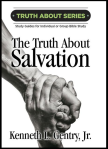
The Truth about Salvation By Ken Gentry
A study guide for personal or small group Bible study. Deals with the Christian doctrine of salvation from a Reformed theological perspective. It opens with a study of God as loving Creator, the shows how the first man fell into sin. Shows God’s righteousness requires that sin be dealt with. Presents Jesus as both God and man so that he can be man’s Savior. Includes review questions and questions for further study.Twelve chapters are ideal for one quarter of Sunday School.
See more study materials at: www.KennethGentry.com
Third, develop a system of cross references. I have certain base texts, so that I don’t have to wonder where I jotted the cross references on a topic. For instance, on the concept of the “last days,” I have my base note at Hebrews 1:2. In that that is my base note, I know if I turn there I will find a long list of Bible references in the margin that show the last days began in the first century. At each of those other verses in the Scriptures, I simply write in the margin: Hb 1:2. I underline the reference as an indication it refers to my base note. This way, if I happen to forget where my base note is, I can turn to any of the familiar passages and it re-directs me to the base where all the cross references appear.
Fourth, develop a system of pointers. If you want to make a note on some key thought in a particular Bible verse:
Underline the key word in the verse. This will alert you to the key thought and remind you that you have some notes somewhere in your Bible on it.Above the underlined word put a pointer to where the notes are. For instance, “T” means in the top margin of that page in the wide margin space; “B”, the bottom margin; a left or right pointing arrow points to the margin beside the text itself. “N” over the marked word reminds me I have some notes in the rear personalized “note book” which I have inserted in my Bible.Fifth, use your Bible’s small concordance. If you have a system of base notes in your Bible, you can link them with your Bible concordance. If you don’t have a full note book entry recorded in your blank pages (your “note book”), look up “predestine” in the concordance in the back of your Bible. Beside “predestine,” jot the Bible reference to your base note and underline it. If “predestine” does not appear in your concordance, write the word “predestine” in the closest position where it would have been.
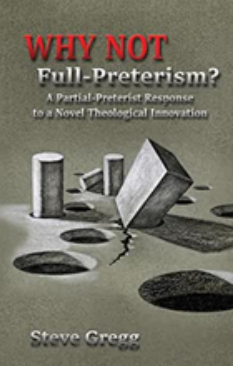
Why Not Full-Preterism? by Steve Gregg
This work exposes some of the key flaws in Hyperpreterism by someone who has formally debated them. Much insightful material for those who might be tempted to forsake historic Christian orthodoxy.
For more Christian educational materials: www.KennethGentry.com
Sixth, if you like to teach Bible studies and relish such opportunities, tuck one of your favorite Bible studies (or sermons) in your Bible. That way, if you are visiting Christian friends somewhere and they ask you to make a few comments on Scripture or offer you the opportunity to teach a class, you will have something organized and available. Of course, if you use your blank sheets effectively, you will have mini-Bible studies available in the back of your Bible.
Seventh, transfer your notes in an orderly fashion. When you buy a new Bible, begin at Genesis and leaf through your old, well-marked Bible one page at a time. Carefully and legibly transfer the notes that are truly helpful from your old to your new Bible. Do this as soon as you can, so that you will have your cherished notes at your finger tips.
Conclusion
These are just a few of the procedures I use for taking notes in my Bible. I have found them to be extremely helpful (especially the older and more feeble I get!). If you give thought to your note taking methods, you will find that you can create an invaluable, personalized, long-lasting “Study Bible.” Who know? If you find enough colorful pictures or simple charts, you might be able to market your Bible and make a fortune. Unless, of course, you are Raptured before the project is completed.
Kenneth L. Gentry Jr.'s Blog
- Kenneth L. Gentry Jr.'s profile
- 85 followers



